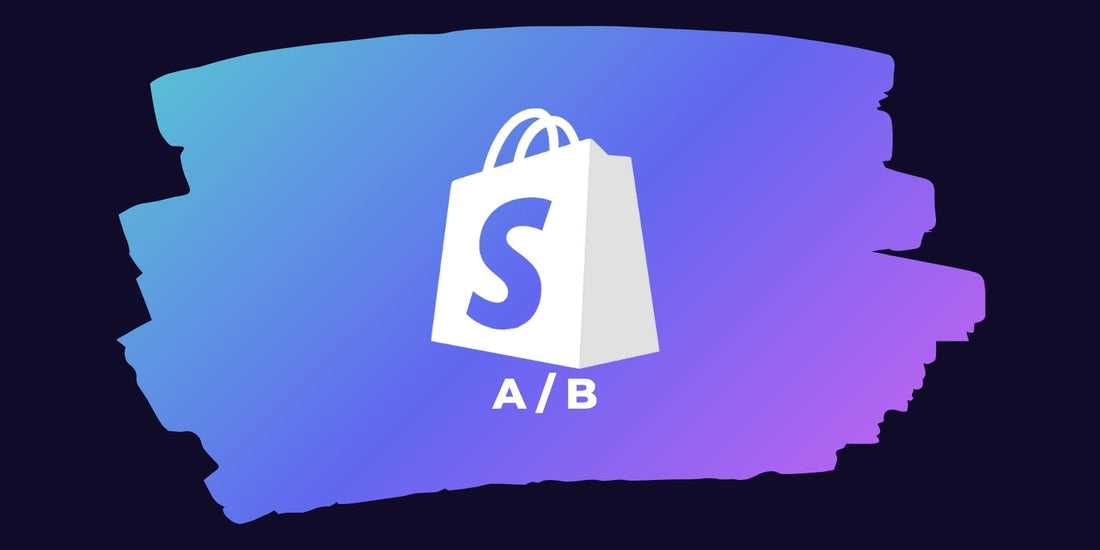
How to test different product page variations on the Shopify platform?
How to test different product page variations in Shopify?
Every e-commerce store owner has one goal in mind: to increase sales and conversion rates. However, it’s often unclear which specific elements of a product page have the greatest impact on customer behavior. That’s why testing different variations of your product pages on Shopify is essential for achieving optimal results. Product page testing (also known as A/B testing or multivariate testing) allows you to measure which elements of design, content, or functionality work best for your audience. 
This comprehensive guide will teach you how to effectively test product page variations on Shopify, from the initial setup to the analysis of results. Whether you’re new to testing or already have experience, these recommendations will help you systematically optimize your e-commerce store’s performance and increase sales.
Why is it worth testing product page variations?
Product pages are critical conversion points where visitors make the decision to buy or leave your site. Even small changes to these pages can have a significant impact on your business results.
Product page testing helps you understand what specifically resonates with your target audience. For example, some buyers are more interested in detailed product specifications, while others are more interested in visual elements. Without testing, you’re left relying solely on assumptions, which can be a risky strategy in e-commerce.
Continuous testing also helps you track changes in user behavior over time. What worked a year ago may not be effective today. Ecommerce optimization strategies based on testing ensure that your product pages always meet current user needs.
Business Impact: Real-World Success Stories
A Lithuanian cosmetics e-commerce store increased conversion rates by 28% after improving product pages based on A/B testing results. The main changes were related to the quality and size of product photos, clearer calls to action, and more informative product descriptions.
Another e-commerce business selling household goods achieved a 15% increase in average order value after a three-month testing cycle that optimized its pricing strategy and added video content elements to product pages.
These examples show that methodically improving your product pages can directly impact your business’s revenue and profitability. However, success requires a strategic approach to the testing process.
Preparation: What to test and how to set clear goals
Before starting any testing, it is necessary to set specific goals and plan what exactly you want to achieve. Testing without a clear strategy often ends in unclear results and a waste of time.
Start with data analysis. Review your existing Shopify analytics data to identify problem areas. 
Pay attention to pages with a high bounce rate, low conversion rate, or short average time spent by visitors.
When formulating your testing hypothesis, use the SMART methodology – goals should be specific, measurable, achievable, relevant and time-bound. For example, instead of “increase sales”, formulate: “increase conversion rate for product X by 10% in 30 days by changing product photos and description”.
Product page elements with the most impact
- Product photos and gallery – high-quality photos taken from different angles, 360° views or videos of the product in use
- Product name – an informative, attractive, and keyword-rich name
- Pricing and promotion – price placement, discount tags, volume discounts
- Call to action (CTA) – buttons, their color, size, text and position on the page
- Product description – structure, length, formatting, highlighted benefits
- Social proof – reviews, ratings, buyer photos
- Choice options – method of selecting options (drop-down menu, color swatches)
- Related Products Section – Recommendation Algorithm, Presentation Method
- Availability information – stock status, delivery time
Start with the elements that traditionally have the biggest impact on conversions – images, call-to-action buttons, and product descriptions – to see the benefits and results of your testing the fastest.
Methods for testing product page variations on Shopify
There are several ways to test different variations of product pages in Shopify. Each method has its own advantages and disadvantages, so it's important to choose the right method for your specific needs. 
The platform allows you to use native Shopify tools, third-party A/B testing apps, or manual methods to create duplicate products or pages. The choice often depends on your technical background, budget, and testing scope.
For beginners, we recommend using specialized Shopify apps, as they simplify the testing process and require the least technical knowledge. More experienced users may prefer more complex solutions that allow for more in-depth testing.
Step by step: creating your first test
- Choose a testing tool – popular Shopify split testing apps include Neat A/B Testing, EasyA/B, Shogun Page Builder, or GemPages.
- Identify the element to be tested – choose a specific element (e.g. product photo, CTA button) and create an alternative variation
- Set measurement parameters – define what data you will collect (conversion rate, average order value, cart additions)
- Set the duration of the test – a minimum of 2 weeks is recommended or until you have collected a statistically significant amount of data
- Configure traffic distribution – usually 50/50 between original and test variant
- Activate the test – once you have run the test, avoid making additional changes during the test period
- Monitor results – review data regularly, but don’t jump to conclusions too soon
It is important to note that when testing, you should only change one element at a time. This will allow you to determine exactly which change affected the results. Multivariate testing can be used later, as you gain more experience.
For beginners, we recommend starting with simple changes, such as the color or text of your call-to-action button. This will allow you to quickly see results and gain experience with testing before moving on to more complex experiments.
Measuring results and making data-driven decisions
Once you have collected your testing data, it is important to interpret it properly and make informed decisions. It is not enough to just look at the overall numbers – a deeper analysis is necessary.
You can use built-in Shopify tools, third-party app reports, or Google Analytics to analyze your data. The key is to understand whether your results are statistically significant and reflect real changes in user behavior.
When evaluating A/B testing results, pay attention not only to the primary conversion metric, but also to secondary metrics such as average order value, bounce rate, or average time on page. Sometimes changes can have unexpected effects on different aspects of user behavior.
Avoiding the most common mistakes in Shopify A/B testing
- Stopping the test too early – don’t make decisions until you have collected a statistically significant amount of data
- Changing multiple items at once - you won't be able to determine which change affected the results
- Ignoring seasonal fluctuations – assess whether there were any unusual factors (holidays, promotions) during the test
- Using a non-representative sample – the test must include a sufficient number of visitors to obtain reliable results
- Disregarding successful test results – ensure successful changes are implemented across the store
- Ignoring context – assess whether the test results are applicable to all products or only to a specific category
After a successful test, implement the changes and continue to monitor the results over time. Ecommerce is constantly changing, so what works today may not be effective in a few months. Product page optimization should be an ongoing process, not a one-time project.
Use the data you get to plan future tests. For example, if you changed your product photos and it increased conversions, you can try different photo styles or layouts in your next test to further improve your results.
Practical tips for effective testing of Shopify product pages
To achieve maximum results, it is worth following certain testing practices that will help you use your time and resources more efficiently.
Prioritize your testing based on potential impact. Start with your most popular product pages or those that generate the most revenue. This will help you see a positive impact on your overall business results faster.
Create a testing calendar with a clear plan of what you will test and when. This will help you improve your e-commerce store systematically and avoid chaotic testing. Ideally, each test should build on the results and insights from previous tests.
Mobile optimization in the testing process
Pay special attention to mobile user experience. Many Shopify stores receive over 60% of their visitors from mobile devices, so it's essential to test how your product pages look and work on different screens.
During testing, make sure that:
- Product images load quickly and are clearly visible on mobile devices
- The call-to-action buttons are large enough and comfortable to press with your finger
- Product variant selection works smoothly on a smaller screen
- The product description is easy to read without horizontal scrolling
Using Shopify analytics and Google Analytics, you can analyze mobile and desktop users separately to determine if your changes are equally effective for both user groups. 
Sometimes what works great on a computer may not be effective on a mobile device and vice versa.
Consolidation of results and further optimization
Successful testing is just the beginning. To maximize the results, it is necessary to implement them properly and continue the optimization process.
Once your testing shows a clear winner, implement the successful changes across all relevant pages. For example, if you find that larger product images increase conversions, apply that change across all product categories.
Testing shouldn’t be a one-time event. Create an ongoing optimization cycle: testing, analyzing, implementing, monitoring, retesting. This will ensure that your e-commerce store is constantly improving and meeting the changing needs of your users.
Advanced testing capabilities
As you gain more experience, you can move on to more complex testing methods:
- Multivariate testing – testing multiple elements simultaneously
- Segmented testing – analysis of the reaction of different user groups to changes
- Sequence testing – multi-page user journey optimization
- Personalization testing – showing different elements to different user segments
These more advanced methods require more traffic and technical expertise, but can provide even more valuable insights into your users' behavior and preferences.
Overview of technological solutions
There are currently a number of tools in the Shopify ecosystem that allow you to effectively test product pages. The choice depends on your technical knowledge, budget, and testing needs.
The most popular Shopify A/B testing apps:
- Neat A/B Testing – easy to use, suitable for beginners
- Convert – an advanced tool with detailed analytics
- VWO – a comprehensive optimization tool with A/B testing capabilities
- Google Optimize – a free Google tool that integrates with Google Analytics
- Optimizely – a solution for businesses with advanced features
In addition to specialized A/B testing tools, it is also worth mentioning page builders with testing features, such as Shogun Page Builder, GemPages, or PageFly. These tools allow you to not only test, but also create attractive product pages without programming knowledge.
When choosing a tool, consider criteria such as price, testing flexibility, analytics depth, integration with other tools you use, and ease of use. Many apps offer free trials, which are worth taking advantage of before making a final decision.
Conclusions
Product page variation testing is an essential tool for any Shopify store owner looking to maximize conversions and improve user experience. By systematically testing a variety of elements—from product photos to call-to-action buttons—you can make data-driven decisions that directly impact your business results.
Start with simple tests and clear goals. Choose one element you want to improve, create an alternative version, and run the test. Analyze the results carefully and don’t jump to conclusions. Implement successful changes and continue the optimization process continuously.
Remember that optimizing your product pages is not a one-time project, but an ongoing process. User expectations and behavior change, so regular testing will help you stay competitive and ensure the best possible user experience on your Shopify store.
Frequently Asked Questions (FAQ)
What is the easiest way to do A/B testing for a product page on Shopify?
Most users start by installing a specialized Shopify A/B testing app that helps you create and track variations without any coding knowledge. The most popular apps are Neat A/B Testing, Convert, and VWO.
How long should I run a Shopify product page test?
Tests should be run for at least two full sales cycles (typically 2-4 weeks) or until you have collected enough data to reach statistical significance. Lower-traffic stores may need a longer period.
What elements on a product page have the greatest impact on conversion rate?
According to industry research, the headline, product photos, price presentation, call-to-action buttons, and social proof (reviews/testimonials) have the greatest impact on conversions.
Can I run multiple tests at once on Shopify?
This depends on the testing tool you use; some third-party apps and specialized solutions support multivariate testing, but for beginners, it is recommended to focus on one change at a time.
Do I need programming knowledge to test Shopify product pages?
No – most modern Shopify split testing apps are designed for the non-technical user, although more complex experiments can benefit from developer support. You can get started without any programming knowledge.